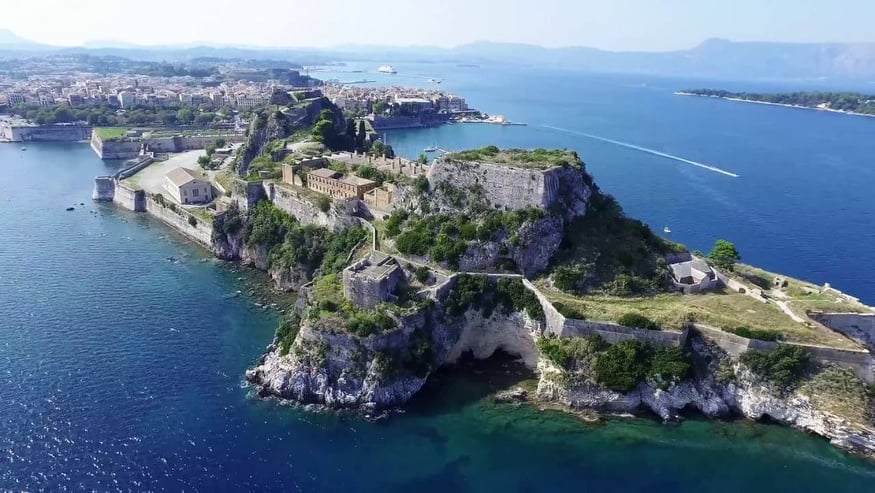
You are using the Free Edition of CorfuAPP. For extensive information on Corfu, GO PRIME with our comprehensive Greek Travel App featuring the full editions of Corfu and 25 more Greek islands & Athens.
more…

Since the 8th century BC the island the Greeks call Kerkyra has been prized for its untamed beauty and strategic location. Ancient armies fought to possess it, while in the early days of modern Greece it was a beacon of learning. Corfiots remain proud of their intellectual and artistic roots.
Corfu is part of the Ionian Islands and lies in the north of the group, at the entrance of the Adriatic Sea, facing Albania. It is the second largest island of the Ionian group after Kefalonia. Shaped like a sickle, with its hollow side facing inwards, the island is about 65 kilometres long and 32 kilometres across at its widest point. There is 217 kilometres of diverse coastline, although anyone venturing inland will find that the interior has at least as much to offer as the shore. Much of Corfu is mountainous. At 906 metres above sea level, its highest peak, Mount Pantokrator, is visible from most places on the island.
The island has a local population of around 112 000 inabitants, and the economy is mainly based on tourism, however a small part is still related to agriculture, with islanders producing high-quality olive oil and wines throughout the mountainous villages. There are 209 towns and villages on Corfu.
Because of the mild Mediterranean climate and the high rainfalls during winter, Corfu is full of abundant and verdant vegetation and wild plants, and is one of the greenest islands in Greece. The island is mountainous, yet also boasts several flat areas, plains, two lakes and a couple of rivers to complete the beautiful landscape.
The capital of the island is called Corfu Town and is also the main port. This is the largest town of the Ionians and one of the most beautiful towns of the Greek islands. Imbued with Venetian grace and elegance, historic Corfu Town (also known as Kerkyra) stands halfway down the island’s east coast. The name Corfu, meaning ‘peaks’, refers to its twin hills, each topped by a massive fortress built to withstand Ottoman sieges. Sitting between the two, the Old Town is a tight-packed warren of winding lanes, some bursting with fine restaurants, lively bars and intriguing shops, others timeless back alleys where washing lines stretch from balcony to balcony. It also holds some majestic architecture, including the splendid Liston arcade, and high-class museums, along with no fewer than 39 churches. Built between two fortresses and full of superb Italian and French buildings, Byzantine churches and flowered squares, Corfu Town is a real jewel full of innumerable charms and beauties.
The miles of coastline and picturesque beaches are what draws tourists to Corfu each year. Whether you’re looking for quiet sands with calm waters or beaches with plenty of nearby amenities, you’ll find it on Corfu. And after a few days of fun in the sun, set aside some time to explore the island’s unique historical and religious attractions.
When you’re ready to venture to the western side of the island, one-of-a-kind attractions, such as the Paleokastritsa Monastery and the Corfu Donkey Rescue, will be waiting for you. The shores here are kissed by the wind so they’re just as good for kitesurfing as dozing on a beach towel. Halikounas’ dunes border the teeming Korission Lagoon, a saltwater lake that’s home to abundant birdlife. Egrets strut between tufts of glasswort, herons snap at crabs in the shallows, and migratory birds like flamingos pass through.
Head north, and it’s like heading 50 years back in time to the days before mass tourism struck parts of Corfu. The coastal road begins to wind and undulate around the massif formed by the island’s highest peak, Mt Pantokrator (906m) and the scenery becomes ever more attractive, with olive groves dipping down to sapphire waters and hidden coves. Many of the pretty little inlets that punctuate the seafront here hold a delightful village or at least a taverna.
There are three small islands, untouched by tourism and great for total privacy: they are the Diapontia islands, that are Othoni, Mathraki, and Ereikoussa. They can be reached by boat from Agios Stefanos or Sidari.
From the writings of Gerald and Lawrence Durrell to the place where the shipwrecked Odysseus was soothed and sent on his way home, Corfu has been portrayed as an idyll for centuries. Today this reputation has led to parts of the island being overrun by mass tourism, but despite this, the Corfu of literature does still exist. All you need to do is sail around the corner, walk over the next headland or potter about the rugged interior and a place of bountiful produce, cypress-studded hills, vertiginous villages, and sandy coves lapped by cobalt-blue waters awaits.
An international airport with direct flights from all over Europe makes Corfu easy to reach, while the hedonistic atmosphere, the friendly locals and the overall feel-good vibe ensure that you will want to return for more.